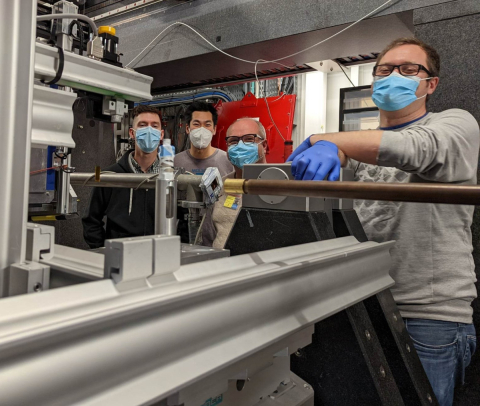A first look inside Li-ion batteries

What if you could charge your electric vehicle in the same amount of time it takes to fill a tank of gas?
In a new paper published today in Joule, researchers from McGill University and the University of Quebec in Montreal (UQAM) announced the development of a novel method that enables researchers to peer inside Li-ion batteries and, for the first time, track the physical processes that take place in both the liquid and solid parts of the battery cells as they happen.
The breakthrough sheds new light on the factors that influence the speed at which Li-ion batteries can be charged or discharged and could lead to fast-charging capabilities in some of the most essential and widely used electronic devices and vehicles, from laptops and cellphones to electric bikes, scooters, and cars.
The research team, led by chemistry professors Janine Mauzeroll at McGill and Steen B. Schougaard at UQAM, in collaboration with the European Synchrotron Radiation Facility (ESRF), used highly concentrated X-rays to look inside Li-ion battery cells and found that the technique succeeded in mapping changes in lithium concentration, in real-time, as the batteries charge or discharge.
“As a Li-ion battery charges or discharges, lithium travels inside the cell in both a liquid electrolyte and a solid active material, and how fast this happens generally depends on how fast the lithium can move from one side of the cell to the other through both these phases,” said Jeremy Dawkins, who worked on the project as a PhD student in Schougaard and Mauzeroll’s labs. “This work is the first report of a method that can map lithium in both the solution and solid phase of a Li-ion battery during the operation of the battery, allowing us to quantify the performance of a cell at the molecular level.”
It’s a development that could have far-reaching implications, from the highly specialized battery research community to just about anyone who uses an electronic device or vehicle. “This work is interesting because it provides a substantial new tool for researchers to study Li-ion battery performance, and it opens a lot of doors that were previously closed off,” Dawkins said. “We hope it will lead to accelerated battery research, for example by obtaining superior electrode architectures much sooner. This could translate to better performance of the batteries we use every day.”
According to the researchers, the project was a COVID-19 success story. Although the McGill and UQAM teams are based in Montreal, the European Synchrotron Radiation Facility, where the measurements were made, is in Grenoble, France. In 2020, when the pandemic hit and governments began implementing travel restrictions, the project was thrown into uncertainty. “The Faculties of Science at McGill and UQAM granted key travel exemptions to make these measurements possible,” Mauzeroll said. “Our collaborators at the ESRF in France did everything they could to measure our samples during the peak pandemic years,” Dawkins added. “Through willpower and more than a sprinkle of luck, our limited measurement time ended up being successful.”
Read the full paper here.